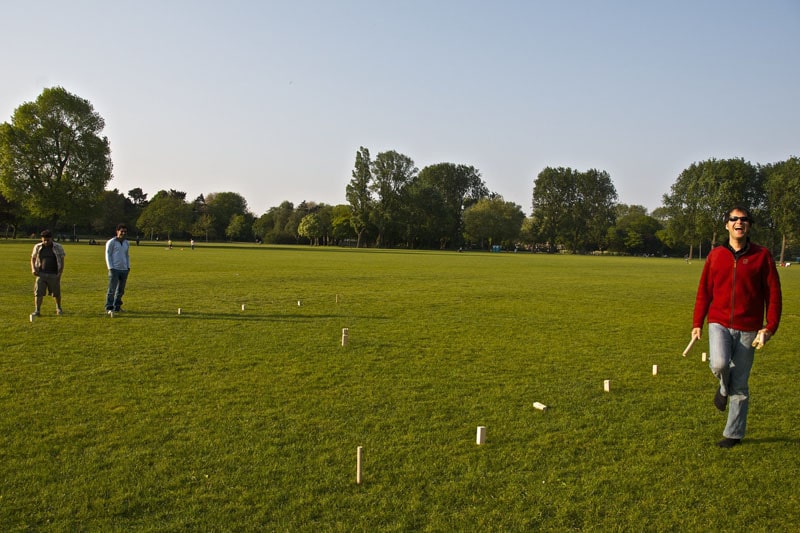Kubb, often referred to as “Viking Chess,” is a captivating lawn game. It blends strategy, skill, and a touch of luck. This game came from Sweden. It has gained worldwide popularity, especially at outdoor gatherings and social events. Understanding Kubb rules is essential for mastering the game. The goal is to knock over your opponent’s wooden blocks (Kubbs) and then topple the King to win.
Game Components
A standard Kubb set consists of several key components, each with a specific role in gameplay. Here’s a breakdown of what you’ll need to play the game:
- Kubbs: These are the rectangular wooden blocks that each team must knock over. A typical Kubb set includes ten Kubbs, five for each team.
- The King: The King is a larger wooden block placed in the center of the playing field. Toppling the King is the ultimate goal to win the game. But it can only be knocked over after all the opponent’s Kubbs are down.
- Batons: Six wooden batons are used by players to knock down the Kubbs. These are thrown underhand and play a crucial role in the strategy of the game.
- Field Markers: Some sets include markers to help set up the field. But, you can also improvise with sticks or cones.

Field Setup and Dimensions
The standard Kubb field is a rectangular area that measures 5 meters by 8 meters. Here’s how to set it up:
- Mark the Field: Use field markers or any suitable objects to mark out the 5×8 meter playing area. The shorter sides are called the baselines, and this is where each team’s Kubbs are placed.
- Position the Kubbs: Each team places five Kubbs, spaced evenly, along their baseline.
- Place the King: The King is placed exactly in the center of the field, equidistant from both baselines.

With the components ready and the field set up, you’re prepared to start the game.
How to Play Kubb
Kubb is played in phases, with each phase requiring a combination of skill and strategy. Here’s how the game unfolds:
- At the start of the game, a toss is used to determine which team goes first. Each team throws one baton toward the King from behind their baseline. The team whose baton lands closest to the King without knocking it over is awarded the first turn.
- The game begins with the 2-4-6 opening to keep the game fair and interesting.
- The opposing team throws any knocked-down Kubbs onto the opponent’s half of the field. These Kubbs become “field Kubbs.” They must be knocked down before the baseline Kubbs can be attacked again.
- The opposing team picks up the knocked-down Kubbs and tosses them into the opponent’s half of the field. These Kubbs must be placed upright where they land.
- A team must first knock down all the field Kubbs on their opponent’s side. Then, they can target the baseline Kubbs again. This creates a back-and-forth. Field Kubbs act as a buffer, protecting the baseline Kubbs.
- If a team successfully knocks down all the field Kubbs in a turn, they can then attack the baseline Kubbs. If they miss any field Kubbs, their opponents can advance. They can throw from the closest field Kubb for a shorter distance to hit the remaining Kubbs.
- Once all of an opponent’s baseline Kubbs are down, the team can attempt to topple the King. The first team to knock over the King wins. But, if they do it before knocking down all the Kubbs, they lose.
Overview of Kubb Rules and Common Variations
- Turn Order: Teams alternate turns, throwing all six batons in each turn after the 2-4-6 opening.
- Throwing Technique: Batons must be thrown underhand and must rotate end over end. Sidearm or helicopter throws are typically against official Kubb rules.
2-4-6 Opening in Kubb
The 2-4-6 opening is a strategy for Kubb. It sets a sequence of initial throws, giving each team a specific number. This method helps in managing the game flow and setting up the field effectively for both teams. Here’s how the 2-4-6 opening works:
- First Team Throws 2 Batons: The game begins with the first team throwing two batons. The objective is to make early progress by knocking down a couple of the opponent’s baseline Kubbs. This phase lets the first team set the stage for the game. They can create helpful Kubb placements for their team.
- Second Team Throws 4 Batons: The second team then throws four batons. Their goal is to respond to the initial throws by knocking down more Kubbs, including those already placed on the opponent’s half of the field.
- All Six Batons for Both Teams: After the initial throws, each team throws all six batons in their subsequent turns. This lets both teams aim for any remaining baseline and field Kubbs from earlier throws.
Winning the Game
Winning a Kubb game requires skill and strategy. Clear Kubb rules define the conditions and endgame that determine the winner. Here’s a detailed look at how to win and some strategies to help you secure the win:
- To win, a team must first knock down all of their opponent’s baseline Kubbs. This step is crucial because it opens up the opportunity to target the King.
- Once all of the opponent’s baseline Kubbs are down, the team can attempt to knock over the King. The King must be hit with a baton, and it must be knocked over completely to secure victory.
- If a team knocks over the King before clearing all baseline Kubbs, the opposition wins.
Conclusion
Kubb is a game that combines strategy, skill, and tradition. It offers a unique, engaging experience for players of all ages. Mastering Kubb rules is crucial for fully enjoying the game. It requires careful planning, precise throwing, and strategic placement of Kubbs.
Kubb offers endless chances for competition and social fun. Knowing the Kubb rules will improve your game. It will make your experience more rewarding, whether you’re a pro or a newbie.







